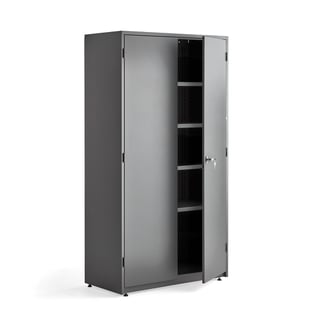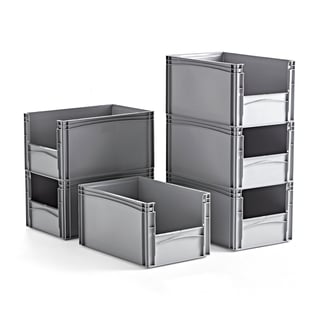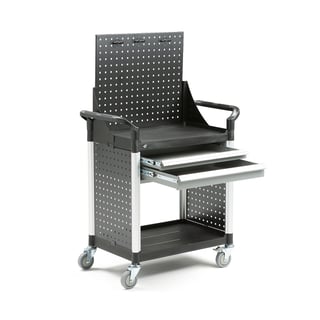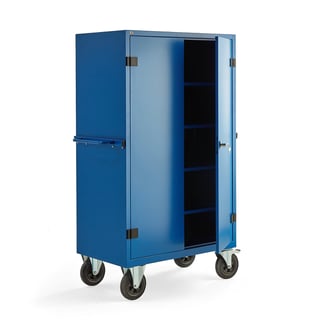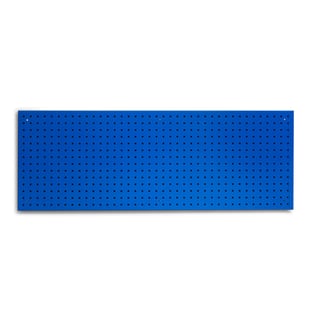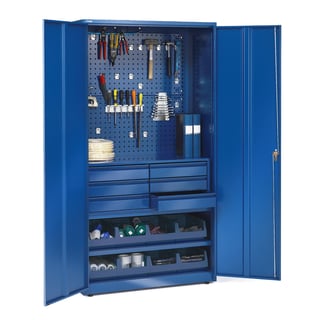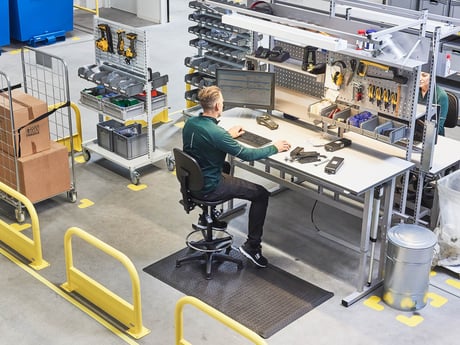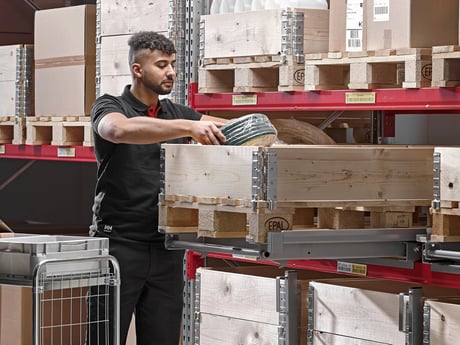
Stop the Search - organise your tools for maximum efficiency.
Do you or your team often feel frustrated when things aren’t where they should be? An organised storage system can transform your workflow, boosting efficiency. Even small improvements in organising tools, materials and equipment can reduce company costs and create a better working environment for everyone.

Clutter is a waste of time!
Constantly searching for tools and materials drains productivity and reduces motivation. By assigning a specific place for each item, your team can quickly find what they need, improving efficiency and focus. The 5S method is a great way to build an organised system, maximizing workspace usage and reducing clutter and stress. With better organisation, you’ll have more time to focus on things that add value to your business!
5 quick tips for better order:
- Label all storage
- Throw away anything old or rusty
- Don't mix small and large items
- Hang things on walls for a good overview
- Keep the most used items closest to you
Disorder comes at a cost
In a messy workspace, items get lost or misplaced, often ending up in unmarked boxes and reappearing some time later. By labeling trays and drawers and using proper storage solutions, you minimize the risk of tools being lost or stolen. This keeps your inventory organised, saves money on replacements and extends the lifespan of machines and tools by reducing unnecessary wear. Smart storage keeps your workspace efficient and your equipment in top shape.
Organise tools with suitable storage
Tool boards - a suitable solution for small spaces. Available on wheels, for inside cupboards and best of all mounted on your workbench. By hanging tools right where you work, you maximize efficiency and make the most of limited space.
Drawers - on wheels or mounted under the table top so the drawers and their contents are easily accessible during work.
Workshop trolleys - have a high load capacity and offer mobility. The carts are made to last a long time and offer a long-term tool solution. Suitable for larger quantities of tools.
Tool cabinets - are adapted both for hand-held and larger tools. They keep equipment protected from dust and dirt and can be locked to prevent unauthorised access.
Battery cabinet - Cordless machines and tools must be kept cool. During charging, the batteries generate heat, which in the worst case can cause a fire. A battery cabinet is both well ventilated and equipped with a warning signal.
Expired batteries? Read more about storage and handling of hazardous waste.
Small parts trays - preferably on a backboard or tray shelf on the workbench so that the contents are easy to reach.
Transparent plastic trays - make it easy to see their contents at a glance, eliminating the need to open multiple drawers or check mislabeled containers. Stackable trays offer even more convenience, maximizing storage space.

Risk Factors - Lifting and Transporting Goods
The journey of a product from manufacturer to customer involves a lot of lifting and moving. Whether you're in manufacturing, wholesale,or retail, investing in an ergonomic work environment can make a big difference. In industries where heavy lifting is common, using the right lifting equipment can help prevent strain injuries. Tools like stackers and pallet lifters simplify and streamline the work, while adapted work trolleys can protect your back when moving lighter items.
Ensure that your lifting equipment matches the layout of your workspace and the type of goods you handle. Single wheels are great for lighter loads on flat surfaces and for handling long sides, while pneumatic rubber tyres are better for heavier loads on uneven floors and ramps.
For manual tasks involving heavier items, a sturdy lifting table can be a game-changer. Height-adjustable lifting tables make it easy to optimise working positions for tasks like packaging or assembly. Lift trolleys can serve as relief tables, work tables and transport solutions.
Advice for Standing at Work
According to the Standing at Work Report from the European Agency for Safety and Health at Work, the prevention strategy should include the following:
- Provide suitable ergonomic workstations and environmental conditions, including an appropriate chair, stool and workstation. For safe and comfortable work, it is important to introduce adjustability (regarding working height, seating, workstations that can be used both standing and sitting, etc.)
- Organise your work to limit standing, balance the tasks to be performed and provide the opportunity to change tasks, breaks if necessary, etc. Give workers sufficient control over how they work, for example giving them opportunities to change how they work and take breaks when needed. It may be appropriate to establish maximum times for standing.
- Introduce additional measures to reduce risks if standing cannot be avoided, such as mats and cushioning insoles.
- Encourage consultation and active employee participation – this is important to all aspects of the strategy.

Risk Factors - Lifting and Transporting Goods
The journey of a product from manufacturer to customer involves a lot of lifting and moving. Whether you're in manufacturing, wholesale,or retail, investing in an ergonomic work environment can make a big difference. In industries where heavy lifting is common, using the right lifting equipment can help prevent strain injuries. Tools like stackers and pallet lifters simplify and streamline the work, while adapted work trolleys can protect your back when moving lighter items.
Ensure that your lifting equipment matches the layout of your workspace and the type of goods you handle. Single wheels are great for lighter loads on flat surfaces and for handling long sides, while pneumatic rubber tyres are better for heavier loads on uneven floors and ramps.
For manual tasks involving heavier items, a sturdy lifting table can be a game-changer. Height-adjustable lifting tables make it easy to optimise working positions for tasks like packaging or assembly. Lift trolleys can serve as relief tables, work tables and transport solutions.
Advice for Standing at Work
According to the Standing at Work Report from the European Agency for Safety and Health at Work, the prevention strategy should include the following:
- Provide suitable ergonomic workstations and environmental conditions, including an appropriate chair, stool and workstation. For safe and comfortable work, it is important to introduce adjustability (regarding working height, seating, workstations that can be used both standing and sitting, etc.)
- Organise your work to limit standing, balance the tasks to be performed and provide the opportunity to change tasks, breaks if necessary, etc. Give workers sufficient control over how they work, for example giving them opportunities to change how they work and take breaks when needed. It may be appropriate to establish maximum times for standing.
- Introduce additional measures to reduce risks if standing cannot be avoided, such as mats and cushioning insoles.
- Encourage consultation and active employee participation – this is important to all aspects of the strategy.

Advice for Standing at Work
According to the Standing at Work Report from the European Agency for Safety and Health at Work, the prevention strategy should include the following:
- Provide suitable ergonomic workstations and environmental conditions, including an appropriate chair, stool and workstation. For safe and comfortable work, it is important to introduce adjustability (regarding working height, seating, workstations that can be used both standing and sitting, etc.)
- Organise your work to limit standing, balance the tasks to be performed and provide the opportunity to change tasks, breaks if necessary, etc. Give workers sufficient control over how they work, for example giving them opportunities to change how they work and take breaks when needed. It may be appropriate to establish maximum times for standing.
- Introduce additional measures to reduce risks if standing cannot be avoided, such as mats and cushioning insoles.
- Encourage consultation and active employee participation – this is important to all aspects of the strategy.
